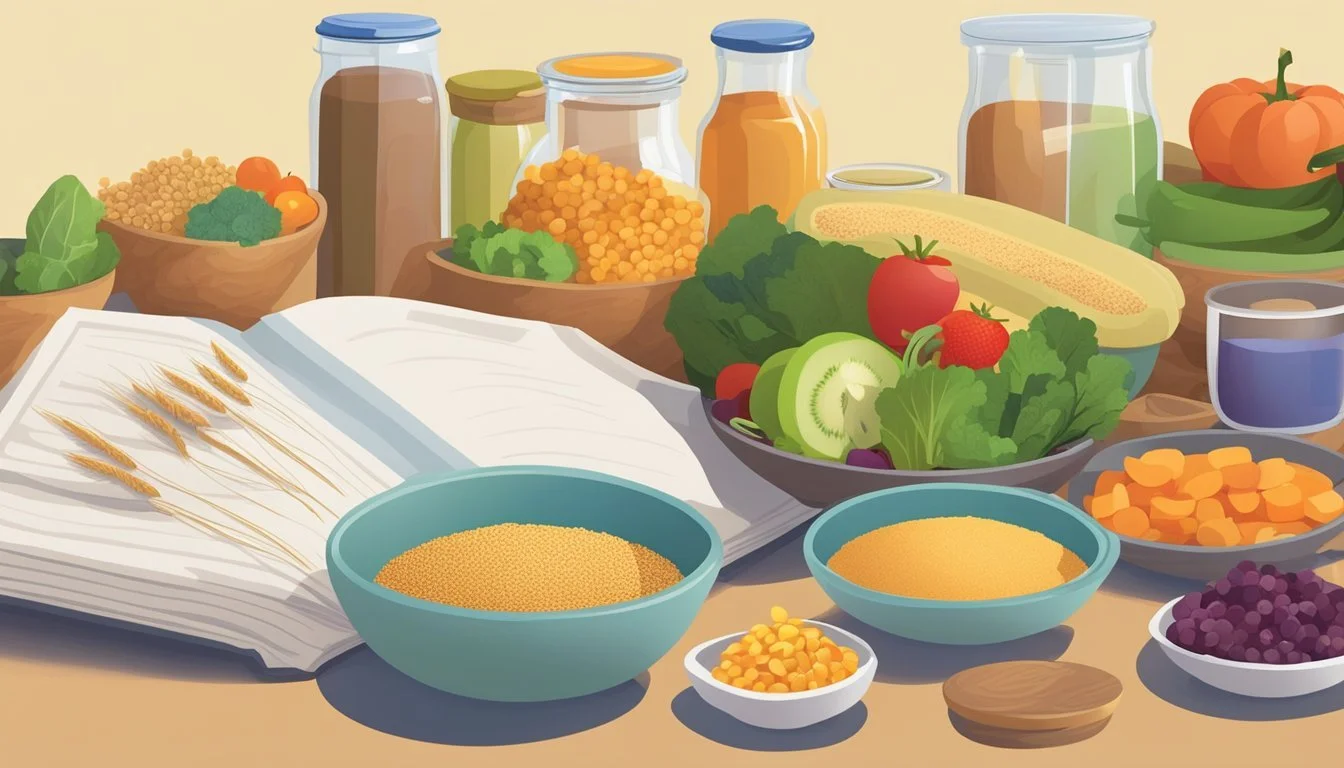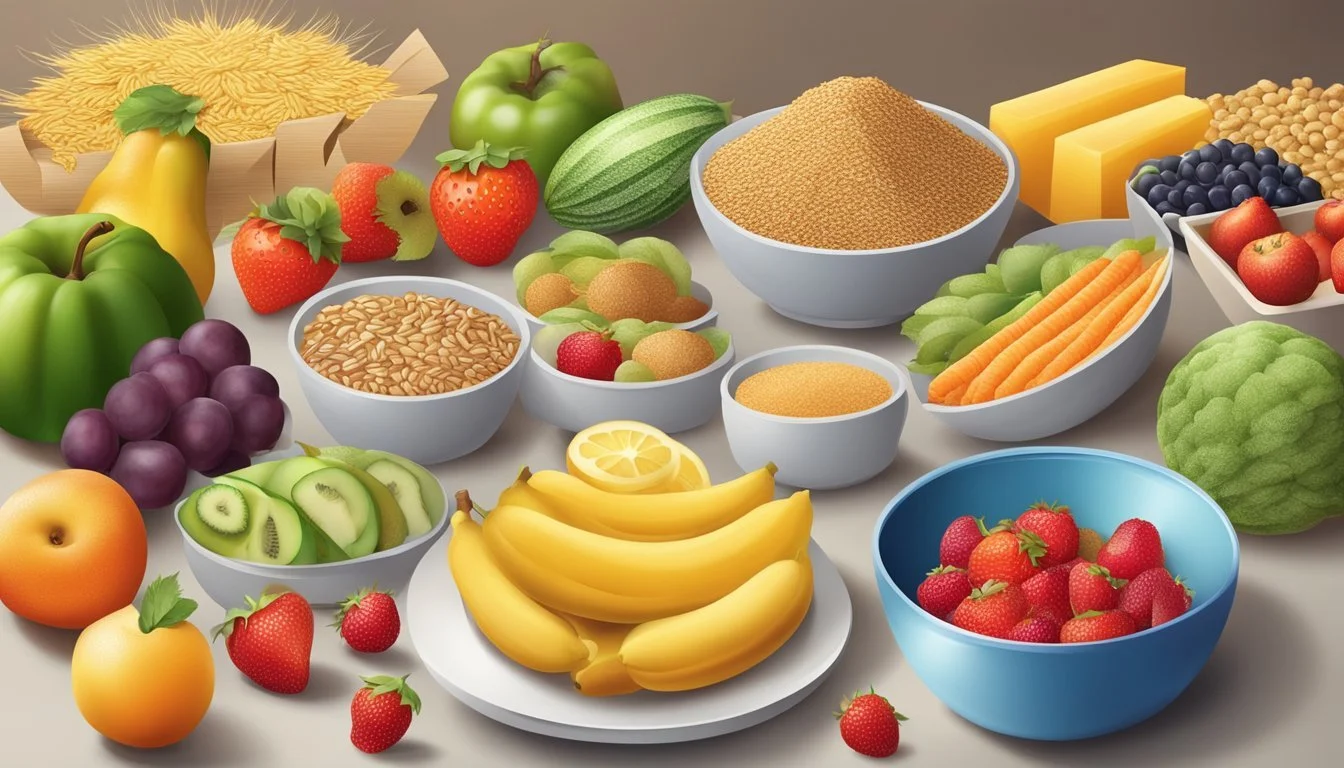Best Foods for Diabetics to Manage Blood Sugar
Top Nutritional Choices
Managing blood sugar levels is a critical aspect of living well with diabetes and reducing the risk of complications associated with the condition. A healthy diet plays a pivotal role in achieving that balance. For individuals with diabetes, selecting the right foods is not just about reducing sugar intake; it's also about consuming a diverse range of foods that contribute to stable blood sugar levels over time.
For those seeking to manage diabetes effectively, a balanced eating plan typically includes a variety of nutrient-rich foods that are low in fat and calories. This approach positions fruits, vegetables, and whole grains as staples in the diabetic diet. Consistency with meal timing and portion sizes can significantly influence blood sugar levels and overall health.
Including specific foods that have a minimal impact on blood sugar can make meal planning easier. Bell peppers, for example, offer a sweet flavor without the sugar rush, making them an excellent choice for snacks or meal additions. Similarly, incorporating non-starchy vegetables like broccoli, celery, and Brussels sprouts, which are high in fiber and low in carbs, can help in preventing blood sugar spikes. These foods not only support diabetic management but are also beneficial for the wider population, promoting overall well-being and health maintenance.
Understanding Diabetes and Blood Sugar Control
Diabetes, a chronic condition characterized by elevated blood sugar levels, is divided into two principal types: type 1 diabetes and type 2 diabetes. Type 1 diabetes occurs when the pancreas produces little or no insulin, the hormone responsible for allowing glucose to enter cells for energy. In contrast, type 2 diabetes is often associated with insulin resistance, where the body's cells do not respond properly to insulin, frequently resulting in high blood sugar levels.
Effective diabetes management requires maintaining blood sugar levels within a target range. Achieving optimal glycemic control involves monitoring blood sugar levels to prevent hyperglycemia (high blood sugar) as well as hypoglycemia, which is a condition of abnormally low blood sugar levels.
Key Components for Blood Sugar Control in Diabetes:
Monitoring: Regular testing of blood sugar levels to detect blood sugar spikes or drops.
Healthy Eating: A diet designed to stabilize blood sugar, often developed with a healthcare provider.
Exercise: Physical activity can help improve insulin sensitivity and lower blood sugar.
Medication: Insulin or other medications may be required, particularly for individuals with type 1 diabetes.
It is essential to recognize the importance of consulting a healthcare provider to create a personalized diabetes management plan. An individualized approach that considers a person's unique medical history, type of diabetes, and lifestyle is fundamental to managing this condition successfully.
The Role of Diet in Managing Diabetes
Managing diabetes effectively requires careful attention to diet, as it has a direct impact on blood sugar levels. A healthy diet for individuals with diabetes is rich in nutrients, low in fat, and moderate in calories. It is essential that the meal plan is structured to support stable blood glucose.
Meal Planning Techniques:
The Plate Method:
Fill half the plate with non-starchy vegetables (e.g., greens, carrots, tomatoes).
One quarter with lean protein (chicken, beans, tofu).
One quarter with carbohydrate-containing foods.
Carbohydrates and Fiber:
Carbs: Monitoring intake is crucial because they have the most immediate effect on blood sugar.
Fiber: High-fiber foods can help control blood sugar levels by slowing the digestion of carbohydrates and sugar.
Simple Carbohydrates: Foods like fruits, milk, and milk products, while natural sources, can raise blood sugar quickly.
Added Sugars: Should be minimized as they contribute to blood glucose spikes without nutritional benefits.
Glycemic Index: Foods with a low glycemic index are preferred as they have less of an impact on blood glucose levels.
Healthy Diet Fundamentals:
Individuals should eat a variety of foods from all food groups.
Portion control is essential to avoid overeating.
Incorporating weight loss strategies into a diet plan can also be beneficial, as excess weight can affect insulin sensitivity. However, any dietary changes should be made under the guidance of healthcare professionals to ensure the safety and effectiveness of the diet in managing diabetes.
Choosing the Right Carbohydrates
When managing blood sugar, selecting carbohydrates wisely is essential. People with diabetes need to focus on fiber-rich foods, understand the glycemic index, and incorporate non-starchy vegetables into their meals.
Whole Grains and Fiber-Rich Foods
Whole grains are an important part of a diabetes-friendly diet, as they contain fiber, which can help regulate blood sugar levels. Fiber-rich foods slow the absorption of sugar, aiding in preventing spikes in blood glucose levels. Options like oatmeal, quinoa, and bread made from whole grains are nutritious choices that provide essential nutrients while aiding in blood sugar control.
Examples of whole grains and fiber-rich foods include:
Brown rice
Barley
Buckwheat
Millet
Understanding the Glycemic Index
The glycemic index (GI) is a helpful tool for people with diabetes. It measures how quickly a food raises blood glucose levels. Foods with a low GI are generally preferred because they cause a slower, steadier rise in blood sugar levels. For instance, whole-grain products typically have a lower GI compared to refined grains.
Low GI foods include:
Non-starchy vegetables
Most fruits
Lentils and beans
Non-Starchy Vegetables
Non-starchy vegetables are low in carbohydrates and high in nutrients, making them an excellent choice for managing diabetes. These vegetables have a minimal impact on blood glucose levels. Vegetables like broccoli, kale, and spinach offer a variety of health benefits in addition to being low in calories and carbohydrates.
Non-starchy vegetables to integrate into a diet:
Broccoli
Cauliflower
Spinach
Kale
These foods can be included in meals or snacks to help maintain stable blood glucose levels.
Incorporating Protein and Healthy Fats into Your Diet
A well-managed diabetic diet integrates varied protein sources and emphasizes the intake of healthy fats to control blood sugar levels effectively.
Lean Protein Choices
Lean protein is essential for diabetics as it has minimal effect on blood sugar while being satisfying. Ideal sources of lean protein include:
Poultry: Skinless turkey and chicken breasts provide high-quality protein without excess fat.
Fish: Especially fatty fish, which is rich in omega-3 fatty acids, such as salmon, mackerel, and sardines, support heart health.
Eggs: A versatile source of protein that can be prepared in numerous ways while being diabetic-friendly.
Meat: When choosing meat, opt for cuts labeled "loin" or "round" as they typically have less fat. Grass-fed options can be healthier.
Dairy products and cheese: Low-fat or fat-free milk, yogurt, and cheese to keep saturated fat in check.
Seeds and Nuts as Nutrient-Rich Options
Both seeds and nuts are powerhouse snacks that deliver protein, healthy fats, and other nutrients without spiking blood sugar.
Nuts: Almonds, walnuts, and pistachios are packed with protein and fiber. They provide healthy fats that can reduce insulin resistance.
Seeds: Chia seeds and flaxseeds not only have protein but also alpha-linolenic acid, which can be converted to omega-3 fatty acids in the body.
Quantity Control: It's important to monitor portion sizes due to the high-calorie content in nuts and seeds.
The Importance of Healthy Fats
A diabetic diet benefits greatly from the inclusion of healthy fats, which can aid in slowing the absorption of glucose into the bloodstream and reduce the risk of heart disease.
Monounsaturated fats: Avocados and olive oil are excellent sources and help improve cholesterol levels.
Polyunsaturated fats: Found in nuts and seeds, these fats also include beneficial omega-3s from fish.
Trans fats and saturated fats: These should be limited, so choosing low-fat or fat-free dairy is wise to avoid unhealthy weight gain.
By selecting the right proteins and healthy fats, those with diabetes can enjoy a diverse, nutrient-rich diet that supports blood sugar management and overall health.
Beneficial Foods for Blood Sugar Regulation
The management of blood sugar levels is crucial for individuals with diabetes. Select foods can help stabilize these levels, primarily due to their fiber content and low glycemic impact. The following subsections shed light on specific foods that are conducive to blood sugar control.
Legumes and Beans
Legumes and beans are an excellent source of plant-based protein and are rich in dietary fiber. Beans, such as black beans and kidney beans, and legumes, including lentils, have a low glycemic index, which means they have a relatively minimal impact on blood sugar levels. Consuming these can help in the slow release of glucose into the bloodstream, providing a steady source of energy and aiding in blood sugar regulation.
Examples of Blood Sugar-Friendly Legumes and Beans:
Black beans
Kidney beans
Lentils
Chickpeas
Fruits and Berries
Fruits, when chosen correctly, can be part of a diabetic-friendly diet. Berries like strawberries and blueberries are high in antioxidants, vitamins, and fiber with a lower sugar content, making them a great choice. Moreover, the fiber in these fruits can slow digestion and prevent rapid spikes in blood sugar.
Low Glycemic Fruits and Berries:
Strawberries
Blueberries
Apples
Vegetables for Low Impact on Blood Sugar
Including a variety of vegetables, especially non-starchy vegetables and leafy greens, can support blood sugar control due to their high fiber content and low carbohydrate levels. These vegetables typically have a negligible effect on blood sugar levels and are packed with essential nutrients.
Examples of Non-Starchy Vegetables:
Broccoli
Cauliflower
Zucchini
Brussels sprouts
Celery
It is vital for individuals to monitor their portions and choose whole, unprocessed foods to integrate these foods effectively into their diet for blood sugar management.
Healthy Snack Options for Diabetics
When selecting snacks, individuals with diabetes should aim for options that help manage blood sugar levels while providing nutritional benefits. Below are specific suggestions categorized by group.
Nuts and Seeds
Nuts and seeds are a powerhouse of nutrients. They are rich in protein, fiber, and healthy fats, which are beneficial for blood sugar control.
Almonds: A small handful (about 23 nuts) is a good serving size.
Walnuts: Provide omega-3 fatty acids, with a serving size being about 14 walnut halves.
Chia Seeds: Mixed into yogurt or a smoothie, use around 1 tablespoon.
Note on portions: too much can lead to excessive calorie intake.
Yogurt and Dairy Alternatives
Yogurt, particularly Greek yogurt, is an excellent snack for those managing diabetes. It's high in protein and lower in carbohydrates than regular yogurt.
Plain Greek yogurt with a sprinkle of nuts or seeds and a few berries maintains a low sugar content while being satisfying.
Dairy-free alternatives such as almond or soy-based yogurts are viable options for those avoiding dairy. Choose unsweetened varieties to avoid added sugars.
Fresh Fruits and Vegetables
Vegetables and fruits are integral to a diabetic-friendly diet but should be chosen wisely considering their sugar content.
Vegetables: Stick to non-starchy ones like broccoli, carrots, or a colorful salad.
Fruits: Opt for berries or a small apple, as they are lower on the glycemic index.
It's advised to pair fruits with a protein or fat source to slow down the sugar absorption. A classic example would be an apple with a piece of cheese or a serving of nut butter.
Meal Planning and Portion Control
Effective meal planning and portion control are critical for diabetics to manage their blood sugar levels. A structured meal plan and understanding the right food portions help maintain a balanced diet and prevent glucose spikes.
The Plate Method
The Plate Method is a simple visual tool to help diabetics construct well-balanced meals with appropriate portion sizes. Using this method, one fills half of their plate with non-starchy vegetables such as broccoli, spinach, or green beans. A quarter of the plate should contain lean protein like fish or poultry, and the remaining quarter is reserved for whole grains or starchy foods. For accuracy, a plate is envisioned as follows:
Half the plate: Non-starchy vegetables
One-quarter of the plate: Lean protein
One-quarter of the plate: Whole grains or other starchy foods
This technique eliminates the need for counting, measuring, or weighing food, simplifying meal planning.
Counting Carbohydrates
Carbohydrate counting entails tracking the total grams of carbohydrates consumed with each meal or snack. It's a precision tool for managing blood glucose levels and can be particularly beneficial in establishing insulin requirements for those on intensive insulin therapy. Diabetics should favor high-fiber carbohydrates which help regulate blood sugar spikes. This practice requires reading food labels and being aware of carbohydrate servings, which typically equate to about 15 grams:
1 small piece of fresh fruit (4 ounces)
1 slice of bread (1 ounce)
1/3 cup of cooked rice or pasta
Portion control is integral to carb counting, and it's essential for individuals to ensure they eat a consistent and appropriate amount of carbohydrates at every meal.
Foods to Avoid or Limit
When managing diabetes, it's important to know which foods can cause a rapid increase in blood sugar levels or contribute to an unhealthy lipid profile. Carefully monitoring and reducing the intake of certain food categories can be instrumental in maintaining health and preventing complications.
High Glycemic Foods
High glycemic foods can cause blood sugar levels to rise quickly. It's beneficial for diabetics to limit foods such as:
White bread: Quickly elevates blood sugar due to simple carbohydrates.
White rice and pasta: Similar to white bread, the lack of fiber results in faster digestion and blood sugar spikes.
Pastries: Usually high in both sugar and fat, contributing to high glycemic load.
Saturated and Trans Fats
Excessive intake of saturated and trans fats can lead to an increased risk of heart disease, which diabetics are already at a higher risk for. Foods to limit include:
Saturated fats: Found in foods like fatty cuts of meat and full-fat dairy.
Trans fats: Often present in fried foods, baked goods, and snacks.
Beverages with Added Sugars
Drinks that are high in added sugars can lead to a significant rise in blood sugar levels. People with diabetes should avoid or strictly limit the following:
Soda: Contains high amounts of sugar and virtually no nutritional value.
Sweetened beverages: This includes fruit punch, lemonade, and many energy drinks that are loaded with sugar.
By being mindful of these categories, diabetics can better manage their condition and contribute to their overall health.
Supplements and Natural Remedies
Navigating the landscape of supplements and natural remedies can be complex, but certain options like specific spices and herbal teas have garnered attention for their potential to support blood sugar management.
Cinnamon and Other Spices
Cinnamon is among the most researched spices concerning blood sugar regulation. Studies suggest that cinnamon may have a beneficial effect in lowering fasting blood glucose. While not a replacement for diabetes medication, it may be a helpful adjunct for some individuals when used in moderation. Other spices like turmeric, which contains curcumin, may also offer benefits due to their anti-inflammatory properties.
Relevant supplements include:
Magnesium: This mineral plays a crucial role in glucose control and insulin metabolism. Diets rich in magnesium may be beneficial for preventing type 2 diabetes in many individuals.
Omega-3 fatty acids: Found in fish oil and flaxseeds, omega-3s can help improve insulin sensitivity and reduce inflammation.
Herbal Teas and Infusions
Herbal teas, free from caffeine and rich in antioxidants, can be a wise choice for those managing their blood sugar levels. Specific teas to consider include green tea, known for its potential to improve insulin sensitivity, and other herbal infusions like chamomile, which may have a mild effect on blood sugar control due to their anti-inflammatory properties.
Suggested teas include:
Green tea: Contains polyphenols that may help with blood sugar regulation.
Chamomile tea: Some studies suggest it may assist in modest blood sugar control.
When considering supplements or natural remedies, individuals should consult with healthcare professionals to ensure these options fit within their overall diabetes management plan.
Lifestyle Considerations for Blood Sugar Management
Managing blood sugar is a multifaceted endeavor that extends beyond food choices for those with diabetes. A structured lifestyle supports stable blood sugar levels and improves insulin sensitivity. Regular exercise is essential; it helps the body use glucose more effectively, contributing to weight loss and better overall health.
Exercise: Encouraging moderate to vigorous physical activity can enhance insulin sensitivity. Adults should aim for at least 150 minutes of aerobic exercise per week.
Types of Exercise:
Aerobic (e.g., walking, swimming)
Resistance training (e.g., weights, resistance bands)
Flexibility exercises (e.g., yoga, stretching)
Weight Management: Maintaining a healthy weight is crucial for managing blood sugar and reducing the risk of complications. Weight loss, as appropriate, can improve cholesterol levels and reduce the burden on the body’s ability to regulate blood sugar.
Stress Reduction: Chronic stress affects blood sugar levels by triggering the release of hormones such as cortisol, which can increase glucose production. Techniques for managing stress include:
Mindfulness meditation
Deep breathing exercises
Regular physical activity
Sleep Hygiene: Adequate sleep is important for blood sugar control. Poor sleep can affect the body's ability to regulate glucose levels.
Routine: Establishing and maintaining a daily routine with regular mealtimes supports consistent blood sugar levels and can prevent spikes and dips.
In summary, patients should adopt a holistic approach to their lifestyle, integrating physical activity, stress management, weight control, and a regular daily schedule to effectively manage their blood sugar levels.





